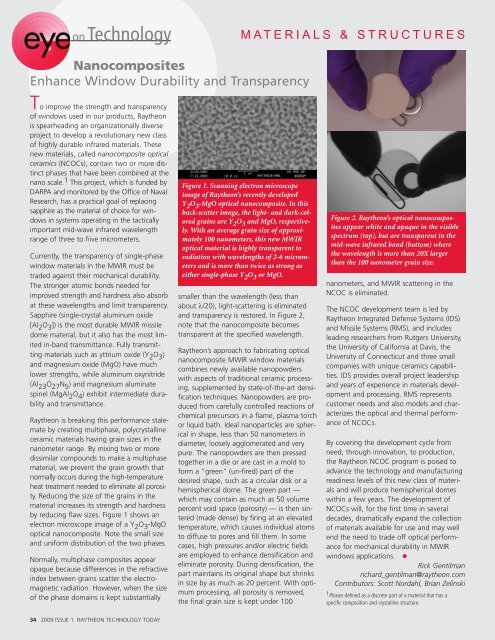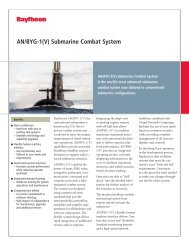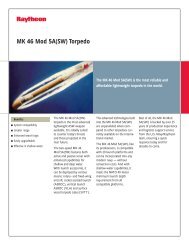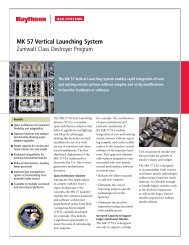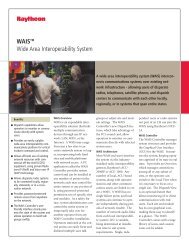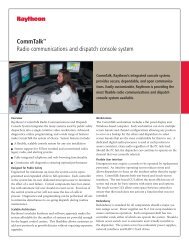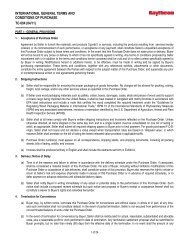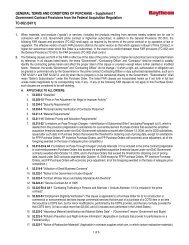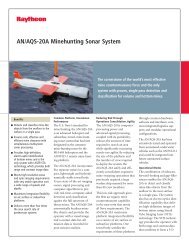Tech_Issue 1 2009_0127_Final:TechToday_012709 ... - Raytheon
Tech_Issue 1 2009_0127_Final:TechToday_012709 ... - Raytheon
Tech_Issue 1 2009_0127_Final:TechToday_012709 ... - Raytheon
You also want an ePaper? Increase the reach of your titles
YUMPU automatically turns print PDFs into web optimized ePapers that Google loves.
on<strong>Tech</strong>nology<br />
Nanocomposites<br />
Enhance Window Durability and Transparency<br />
To improve the strength and transparency<br />
of windows used in our products, <strong>Raytheon</strong><br />
is spearheading an organizationally diverse<br />
project to develop a revolutionary new class<br />
of highly durable infrared materials. These<br />
new materials, called nanocomposite optical<br />
ceramics (NCOCs), contain two or more distinct<br />
phases that have been combined at the<br />
nano scale. 1 This project, which is funded by<br />
DARPA and monitored by the Office of Naval<br />
Research, has a practical goal of replacing<br />
sapphire as the material of choice for windows<br />
in systems operating in the tactically<br />
important mid-wave infrared wavelength<br />
range of three to fiive micrometers.<br />
Currently, the transparency of single-phase<br />
window materials in the MWIR must be<br />
traded against their mechanical durability.<br />
The stronger atomic bonds needed for<br />
improved strength and hardness also absorb<br />
at these wavelengths and limit transparency.<br />
Sapphire (single-crystal aluminum oxide<br />
[Al 2 O 3 ]) is the most durable MWIR missile<br />
dome material, but it also has the most limited<br />
in-band transmittance. Fully transmitting<br />
materials such as yttrium oxide (Y 2 O 3 )<br />
and magnesium oxide (MgO) have much<br />
lower strengths, while aluminum oxynitride<br />
(Al 23 O 27 N 5 ) and magnesium aluminate<br />
spinel (MgAl 2 O 4 ) exhibit intermediate durability<br />
and transmittance.<br />
<strong>Raytheon</strong> is breaking this performance stalemate<br />
by creating multiphase, polycrystalline<br />
ceramic materials having grain sizes in the<br />
nanometer range. By mixing two or more<br />
dissimilar compounds to make a multiphase<br />
material, we prevent the grain growth that<br />
normally occurs during the high-temperature<br />
heat treatment needed to eliminate all porosity.<br />
Reducing the size of the grains in the<br />
material increases its strength and hardness<br />
by reducing flaw sizes. Figure 1 shows an<br />
electron microscope image of a Y 2 O 3 -MgO<br />
optical nanocomposite. Note the small size<br />
and uniform distribution of the two phases.<br />
Normally, multiphase composites appear<br />
opaque because differences in the refractive<br />
index between grains scatter the electromagnetic<br />
radiation. However, when the size<br />
of the phase domains is kept substantially<br />
34 <strong>2009</strong> ISSUE 1 RAYTHEON TECHNOLOGY TODAY<br />
MATERIALS & STRUCTURES<br />
Figure 1. Scanning electron microscope<br />
image of <strong>Raytheon</strong>’s recently developed<br />
Y 2 O 3 -MgO optical nanocomposite. In this<br />
back-scatter image, the light- and dark-colored<br />
grains are Y 2 O 3 and MgO, respectively.<br />
With an average grain size of approximately<br />
100 nanometers, this new MWIR<br />
optical material is highly transparent to<br />
radiation with wavelengths of 2-6 micrometers<br />
and is more than twice as strong as<br />
either single-phase Y 2 O 3 or MgO.<br />
smaller than the wavelength (less than<br />
about λ/20), light-scattering is eliminated<br />
and transparency is restored. In Figure 2,<br />
note that the nanocomposite becomes<br />
transparent at the specified wavelength.<br />
<strong>Raytheon</strong>’s approach to fabricating optical<br />
nanocomposite MWIR window materials<br />
combines newly available nanopowders<br />
with aspects of traditional ceramic processing,<br />
supplemented by state-of-the-art densification<br />
techniques. Nanopowders are produced<br />
from carefully controlled reactions of<br />
chemical precursors in a flame, plasma torch<br />
or liquid bath. Ideal nanoparticles are spherical<br />
in shape, less than 50 nanometers in<br />
diameter, loosely agglomerated and very<br />
pure. The nanopowders are then pressed<br />
together in a die or are cast in a mold to<br />
form a “green” (un-fired) part of the<br />
desired shape, such as a circular disk or a<br />
hemispherical dome. The green part —<br />
which may contain as much as 50 volume<br />
percent void space (porosity) — is then sintered<br />
(made dense) by firing at an elevated<br />
temperature, which causes individual atoms<br />
to diffuse to pores and fill them. In some<br />
cases, high pressures and/or electric fields<br />
are employed to enhance densification and<br />
eliminate porosity. During densification, the<br />
part maintains its original shape but shrinks<br />
in size by as much as 20 percent. With optimum<br />
processing, all porosity is removed,<br />
the final grain size is kept under 100<br />
Figure 2. <strong>Raytheon</strong>’s optical nanocomposites<br />
appear white and opaque in the visible<br />
spectrum (top), but are transparent in the<br />
mid-wave infrared band (bottom) where<br />
the wavelength is more than 20X larger<br />
than the 100 nanometer grain size.<br />
nanometers, and MWIR scattering in the<br />
NCOC is eliminated.<br />
The NCOC development team is led by<br />
<strong>Raytheon</strong> Integrated Defense Systems (IDS)<br />
and Missile Systems (RMS), and includes<br />
leading researchers from Rutgers University,<br />
the University of California at Davis, the<br />
University of Connecticut and three small<br />
companies with unique ceramics capabilities.<br />
IDS provides overall project leadership<br />
and years of experience in materials development<br />
and processing. RMS represents<br />
customer needs and also models and characterizes<br />
the optical and thermal performance<br />
of NCOCs.<br />
By covering the development cycle from<br />
need, through innovation, to production,<br />
the <strong>Raytheon</strong> NCOC program is poised to<br />
advance the technology and manufacturing<br />
readiness levels of this new class of materials<br />
and will produce hemispherical domes<br />
within a few years. The development of<br />
NCOCs will, for the first time in several<br />
decades, dramatically expand the collection<br />
of materials available for use and may well<br />
end the need to trade off optical performance<br />
for mechanical durability in MWIR<br />
windows applications.<br />
Rick Gentilman<br />
richard_gentilman@raytheon.com<br />
Contributors: Scott Nordahl, Brian Zelinski<br />
1Phases defined as a discrete part of a material that has a<br />
specific composition and crystalline structure.


